Section 3 - Organisms exchange substances with their environment
1/144
There's no tags or description
Looks like no tags are added yet.
Name | Mastery | Learn | Test | Matching | Spaced |
|---|
No study sessions yet.
145 Terms
What is tissue fluid and its function
It’s a liquid that surrounds body cells and helps exchange substances between blood and cells efficiently.
It supplies cells with oxygen and nutrients.
It removes waste products like carbon dioxide and urea.
What is the main purpose of exchanging substances with the environment?
To take in essential substances (like oxygen, nutrients, water) and remove waste products (like carbon dioxide and urea) for survival and homeostasis).
What are the two ways in which exchanges take place
Passively (no metabolic energy is required), by diffusion and osmosis.
Actively (metabolic energy is required), by active transport.
What is metabolic energy?
Energy released from chemical reactions in cells (metabolism) used for processes like movement, growth, repair.
What is the surface area to volume ratio?
The ratio of an organisms surface area to its volume.
It affects how efficiently substances can enter or leave the cell/organism.
How does surface area to volume ratio affect exchange efficiency?
Smaller cells have high surface area to volume ratio → fast, efficient exchange.
Larger cells/organisms have low surface area to volume ratio → require adaptations like lungs, gills or blood vessels.
Examples of an organism with a high and low surface area to volume ratio.
High → single celled organism (amoeba)
Low → large animal (elephant, human)
How do you ensure the exchange is as effective as possible?
The surface area needs to be as large a possible compared to the volume.
All exchange systems have the same 3 adaptations in common to help increase the rate of exchange of substances by diffusion. What are they?
Thin walls - to create a short distance so diffusion happens faster (e.g. capillaries - walls are one cell thick)
Large surface area - provides more space for substances to diffuse across (e.g. alveoli in lungs, villi in small intestine).
Good blood supply - maintains high concentration difference to speed up diffusion (e.g. rich capillary network around alveoli or villi).
How so single-celled organisms carry out gas exchange?
By diffusion directly through their cell membrane.
Why is diffusion sufficient for gas exchange in single-celled organisms?
They are small, so gases only have to diffuse short distances.
Name three adaptations that make gas exchange efficient in single-celled organisms
Small size → large sa:v ratio
Thin cell membrane
Moist membrane
Why does the cell membrane need to be moist for gas exchange?
Gases dissolve in water on the membrane surface, allowing diffusion to occur faster.
Why can’t insects rely on diffusion through the skin for gas exchange?
They have a hard exoskeleton and a high metabolic rate, so diffusion alone is insufficient.
What is the main gas exchange system in insects?
The tracheal system.
Name the main parts of the tracheal system.
Spiracles
Trachea
Tracheoles
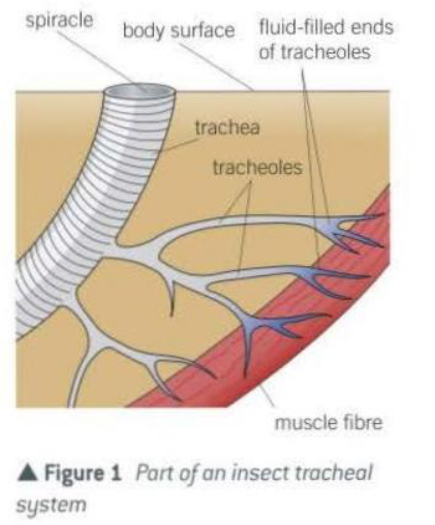
How does oxygen reach the cells in insects?
Oxygen diffuses from the tracheoles directly into the cells along a concentration gradient.
.
Give three adaptations that make gas exchange efficient in insects
Many tracheoles → large surface area.
Thin tracheole walls → short diffusion distance.
Air sacs → store extra oxygen.
How do some insects increase the rate of oxygen movement besides diffusion?
Muscle contractions create mass transport, pushing air along the trachea.
How do gases move in and out of the tracheal system in insects?
Oxygen enters the body through spiracles.
Oxygen diffuses along concentration gradients through the trachea.
Oxygen moves into smaller tubes called tracheoles, which reach individual body cells.
Oxygen diffuses from tracheoles into the cells where it is used for cellular respiration.
Carbon dioxide produced by cells diffuses into the tracheoles.
Carbon dioxide moves up the trachea and diffuses out through the spirals into the air.
Muscle movements in some insects can push air along the trachea, speeding up gas exchange (mass transport)
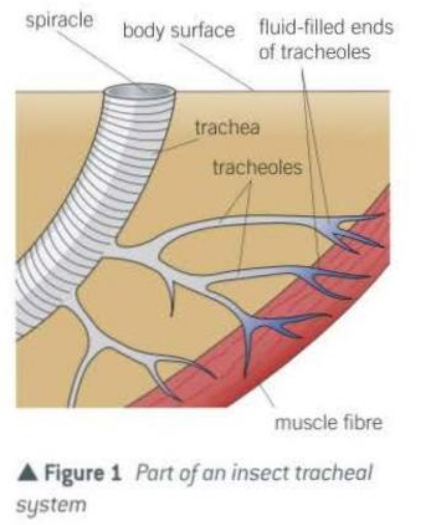
Why are the ends of tracheoles in insects filled with water?
The water at the ends of tracheoles allows oxygen to dissolve, making it easier to diffuse directly into the cells.
During high activity, cells produce a lot of carbon dioxide, which lowers the water potential, drawing water into the cells and exposing more surface area for oxygen to diffuse.
This also helps remove carbon dioxide efficiently from the cells into the tracheoles.
What is a limitation of the insect tracheal system?
Diffusion only works efficiently over short distances.
Oxygen cannot diffuse quickly enough to reach cells in large or active insects.
This limits insect size - they can’t grow too big because oxygen delivery would be too slow to meet metabolic demands.
Why can’t fish rely on diffusion through their skin for gas exchange?
Fish have a large body and low sa:v ratio, so diffusion through the skin alone is not sufficient.
What is the main gas exchange system in fish?
Gills
How are gills structured to maximise gas exchange?
Gill filaments → increase surface area.
Lamellae on filaments → increase surface area.
Thin walls → short diffusion distance.
Rich blood supply → maintains a steep concentration gradient.
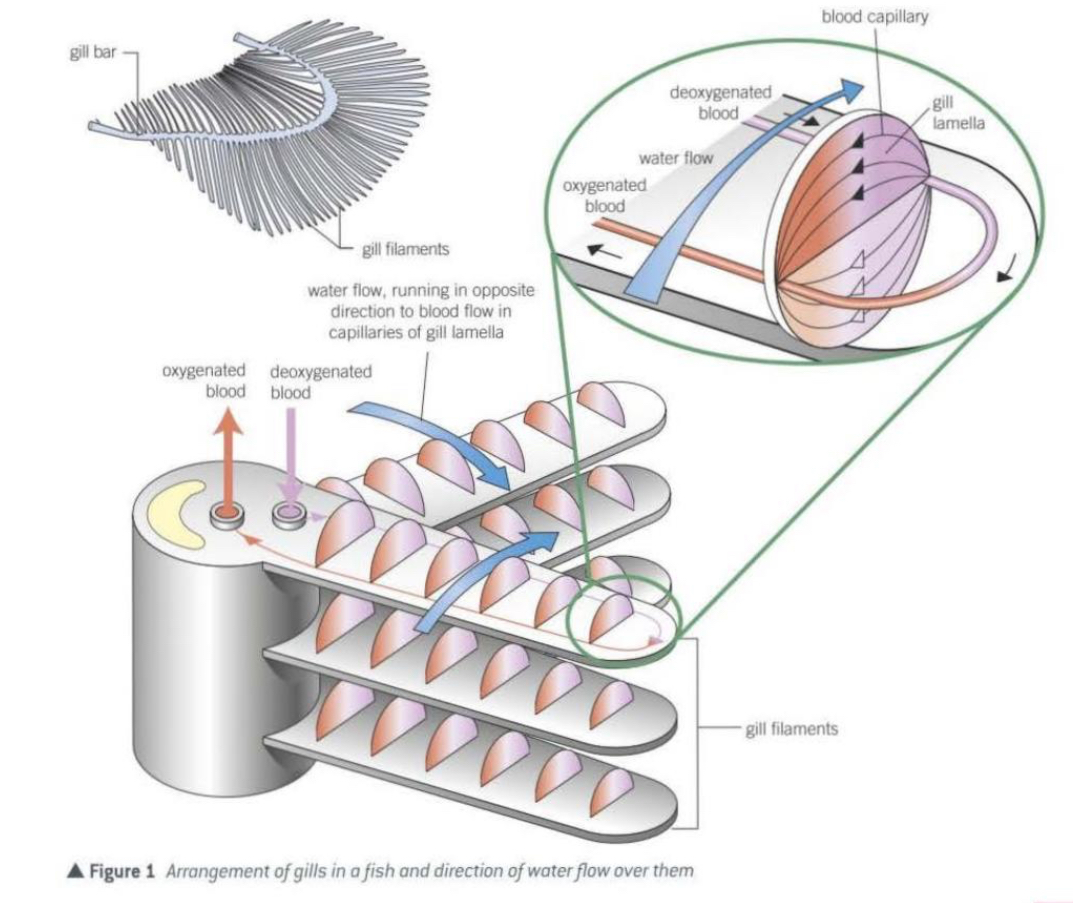
Explain how fish do gas exchange
Water enters the fish’s mouth and flows over the gills.
Oxygen in water diffuses from high concentration in water → low concentration in blood across lamellae walls.
Carbon dioxide in blood diffuses from high concentration → low concentration in water.
Blood and water flow in opposite directions (countercurrent flow) to maintain a steep concentration gradient along the entire gill surface.
Rich blood supply in lamellae ensures oxygen is constantly carried away and carbon dioxide is removed efficiently.
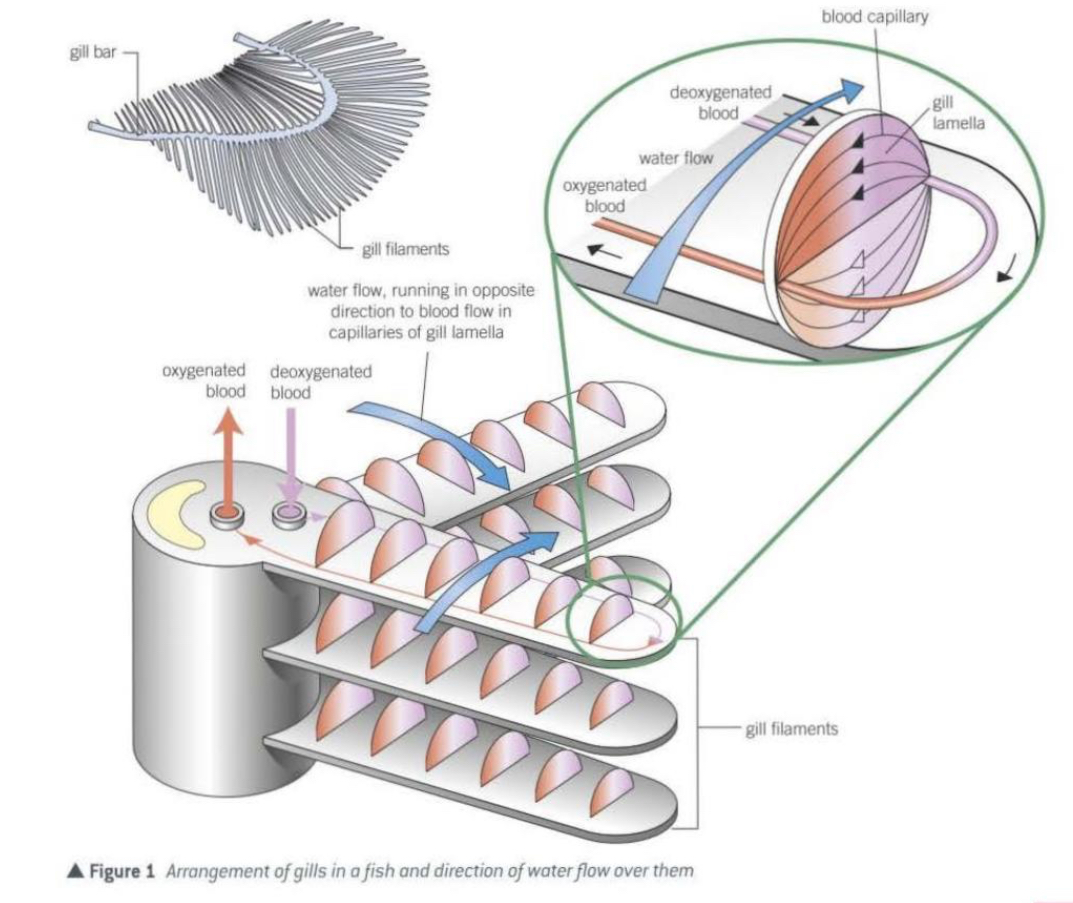
Explain the countercurrent exchange principle
The blood and the water that flow over the gill lamellae do so in opposite directions.
Blood that is already well loaded with oxygen meets water, which has its maximum concentration of oxygen.
Therefore diffusion of oxygen from the water to the blood takes place.
Blood with little oxygen in it meets water which has had most, but not all, of its oxygen removed.
Diffusion of oxygen from the water to blood takes place.
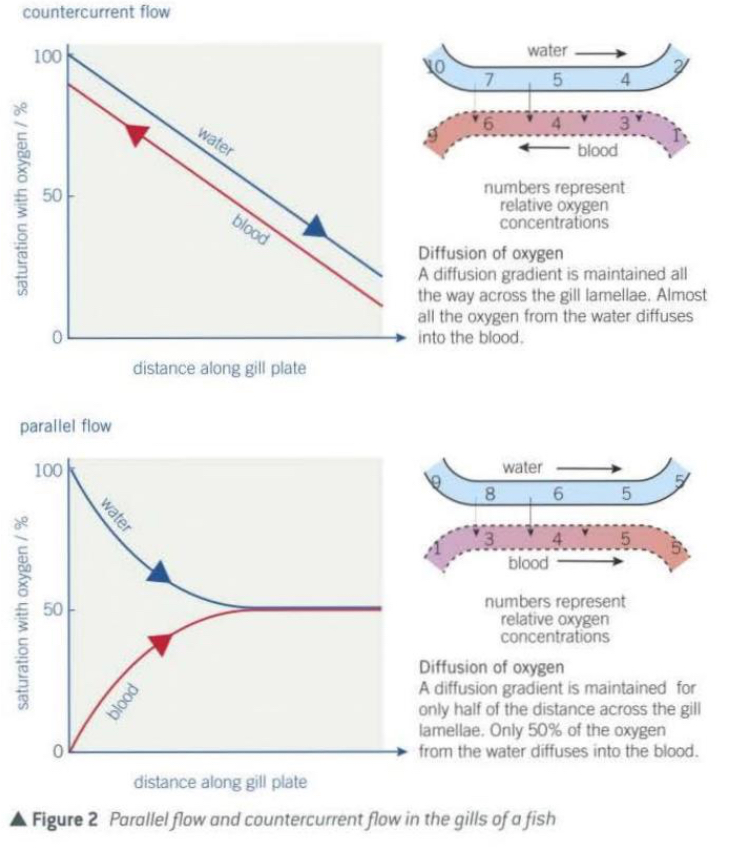
What gases are involved in gas exchange in plants?
Carbon dioxide (CO2)
Oxygen (O2)
Water vapour (H2O)
Why do plants need CO2?
For photosynthesis - to make glucose.
Why do plants release O2?
It’s a by-product of photosynthesis.
Why do plants take in O2 and release CO2 at night?
Because photosynthesis stops without light, so respiration in the cells dominates.
What is the main site of gas exchange in plants?
The leaf.
How are leaves adapted for gas exchange?
Has many small pores, called stomata which open and close, and so no cell is far from a stoma and therefore the diffusion pathway is short.
Large surface area of mesophyll cells for rapid diffusion.
Thin (short diffusion distance).
Air-spaces that occur throughout the mesophyll so that gases can readily come in contact with mesophyll cells.
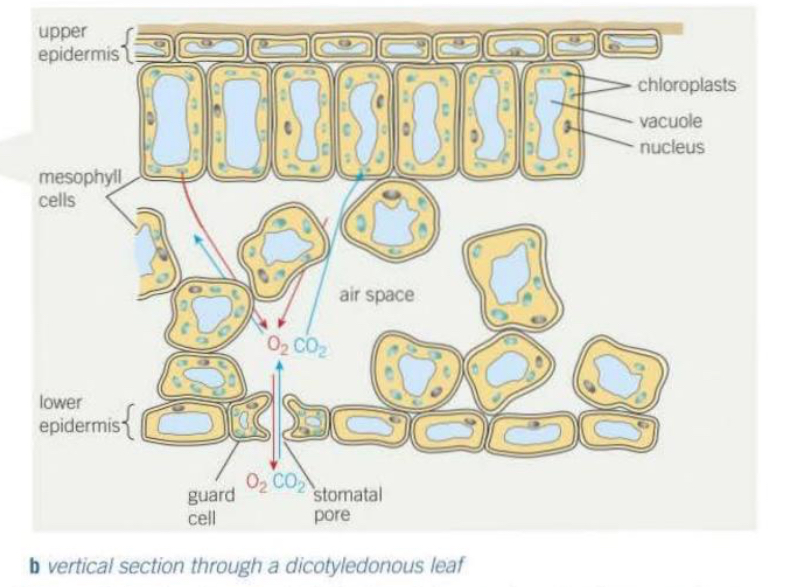
What are stomata?
Small pores mainly on the underside of leaves that allow gas exchange.
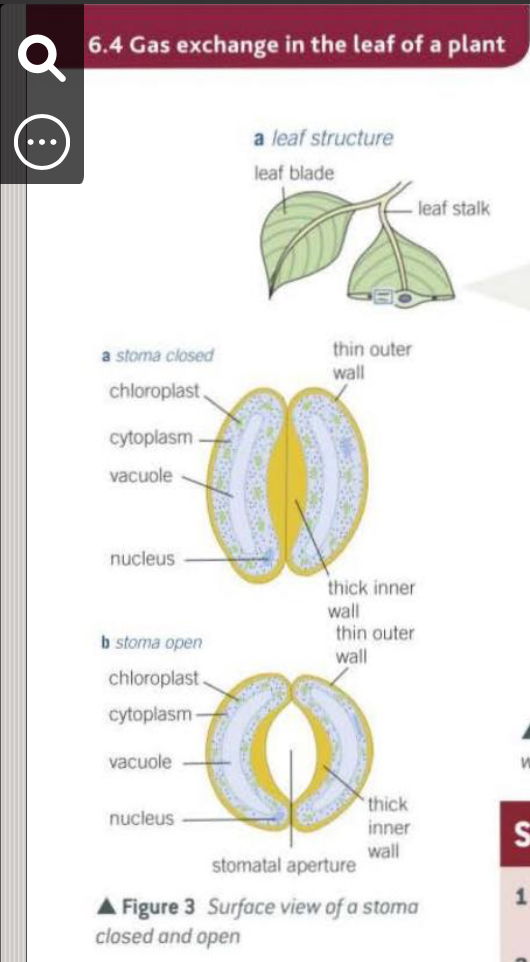
What surrounds the stoma? And what does it do
Each stoma is surrounded by a pair of guard cells.
They control the opening and closing of the stomata.
In this way they can control the rate of gaseous exchange.
This is important because terrestrial organisms lose water by evaporation.
How do guard cells open the stomata?
They take in water by osmosis, become turgid, and curve apart.
How do guard cells close the stomata?
They lose water, become flaccid, and the pore closes.
When are stomata usually open and why?
During the day - to allow CO2 in for photosynthesis.
When are stomata usually closed and why?
At night - to reduce water loss when photosynthesis isn’t happening.
What is the function of the cuticle?
It’s a waxy layer that reduces water loss by evaporation.
Where does most gas diffusion occur in a leaf?
Through the spongy mesophyll, which has many air spaces.
What happens to CO2 in the leaf during the day?
It diffuses in through the stomata and into photosynthesising cells.
What happens to O2 in the leaf during the day?
It diffuses out through stomata as a by-product of photosynthesis.
Why is diffusion sufficient for gas exchange in plants?
Because cells are close to air spaces, and distances are small.
What’s the role of xylem in gas exchange?
It brings water to the leaf, which helps maintain moist surfaces for diffusion.
What is the role of the phloem in gas exchange?
It transports sugars produced in photosynthesis to other parts of the plant.
What is transpiration?
The loss of water vapour from the aerial parts of a plant, mainly through the stomata. (Xerophytes)
How does transpiration link to gas exchange?
Both involve diffusion through stomata - gases move in, water vapour moves out.
How do plants balance gas exchange with water conservation?
By regulating stomata opening through guard cells and hormonal signals (e.g. abscisic acid).
What adaptations do xerophytes have for gas exchange?
Thick, waxy cuticle on the surface of leaves:
Forms a waterproof barrier.
Reduces water loss by evaporation.
Examples: cactus, holly.
Small leaves:
Reduces surface area for water loss.
Less surface → less evaporation.
Examples : cactus spines, pine needles.
Sunken stomata - the stomata are located in pits below the leaf surface.
Traps humid air around the stomata.
Slows diffusion of water vapour out of the leaf.
Examples: cactus, pine.
Leaf hairs - tiny hairs on the leaf surface.
Trap a layer of still, moist air.
The water potential gradient between the inside and the outside of the leaves is reduced → less water is lost by evaporation.
Examples: holly, lambs ear.
Rolled leaves - leaves roll up lengthwise.
Protects stomata inside the roll.
Maintains a humid environment inside the leaf.
This region becomes saturated with water vapour and so has a very high water potential. There is no water potential gradient between the inside and outside of the leaf and therefore no water loss.
Examples: marram grass.
Water storage (succulence) - thick fleshy leaves or stems that store water.
Provides water during dry periods.
Even if some water is lost, the plant has a reserve.
Examples: cactus, aloe vera.
What adaptations do hydrophytes have for gas exchange?
Thin or no cuticle.
Allows gases to diffuse easily into the leaf.
Stomata on upper leaf surface.
Allows gas exchange with air above water.
Stomata would be submerged and useless on the lower surface.
Large, flat leaves - spread out on the water surface.
Maximises surface area for light capture and gas exchange.
Helps photosynthesis and efficient gas diffusion.
Large air spaces (aerenchyma) inside leaves and stems.
Provides buoyancy and allows gases to diffuse to submerged tissues.
Ensures oxygen reaches roots under water.
Flexible stems and leaves.
Can move with water currents.
Prevents damage from water movement.
Examples of hydrophytes
Floating: water Lilly - stomata on upper surface, large flat leaves.
Submerged: elodea - thin leaves, large air spaces, flexible stems
Emergent: reed - aerenchyma in stems for oxygen transport to roots.
How does light intensity affect gas exchange?
Higher light intensity → stomata open wides to allow more CO2 in.
How does humidity affect gas exchange in plants?
High humidity reduces water loss, low humidity increases transpiration.
How does wind speed affect gas exchange in plants?
Increases diffusion rate and water loss by removing humid air near the leaf surface.
How does temperature affect gas exchange in plants?
Higher temperature increases diffusion rate and water loss through evaporation.
What is the intercellular air space?
The gaps between spongy mesophyll cells where gases diffuse freely.
What adaptations do insects have to reduce water loss?
Small surface area to volume ratio to minimise the area over which water is lost.
Waterproof coverings over their body surfaces. In the case of insects this covering is a rigid outer skeleton of chitin that is covered with a waterproof cuticle.
Spiracles are the openings of the tracheae at the body surface and these can be closed to reduce water loss. This conflicts with the need for oxygen and so occurs largely when the insect is at rest.
Why does the volume of oxygen that has to be absorbed and the volume of carbon dioxide that must be removed have to be large in mammals?
They are large organisms with a large volume of living cells.
They maintain a high body temperature which is related to them having high metabolic and respiratory rates.
What is th primary function of the human gas exchange system?
To supply oxygen to the blood for respiration and remove carbon dioxide from the body.
What are the main organs of the human gas exchange system?
Nasal cavity
Trachea
Bronchi
Bronchioles
Alveoli
Lungs
Diaphragm
Intercostal muscles
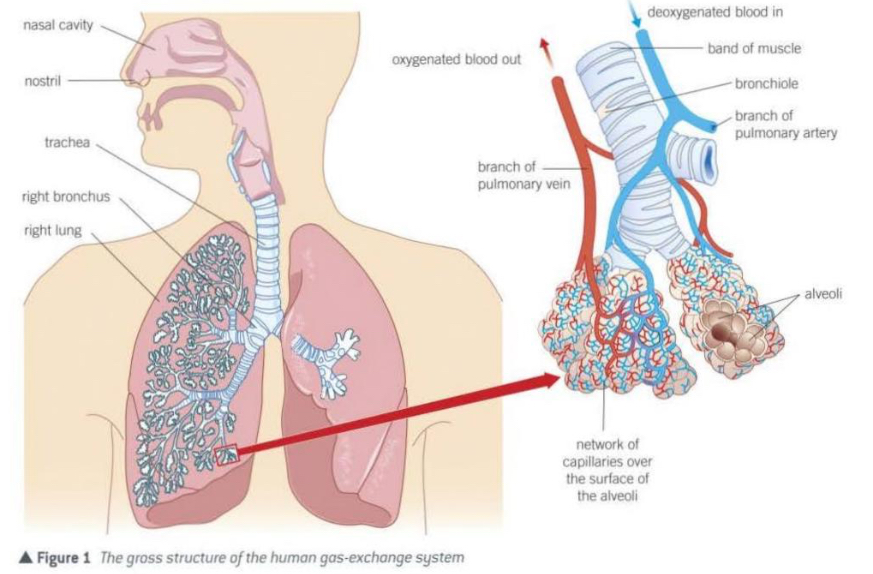
Why are the lungs located inside the body?
Air is not dense enough to support and protect these delicate version of a structure.
The body as a whole would otherwise lose a great deal of water and dry out.
What is the role of the nasal cavity in gas exchange?
Filters, warms and moistens incoming air.
What are the lungs
A pair of lobed structures made up of a series of highly branched tubules, called bronchioles, which end in tiny air sacs called alveoli.
What is the trachea and how is it adapted for its function?
The trachea is a flexible airway that is supported by rings of cartilage.
C-shaped cartilage rings prevent collapse and allow flexibility.
Lined with ciliated epithelium and goblet cells to trap and move dust and pathogens away.
What is the bronchi and what is its role.
Two divisions of the trachea, each leading to one lung.
Similar structure to trachea but smaller.
Carries air from the trachea to each lung.
What are bronchioles and how are they adapted for gas exchange?
A series of branching subdivisions of the bronchi.
Their walls are made of muscle lined with epithelial cells.
This muscle allows them to constrict so that they can control the flow of air in and out of the alveoli.
What is the alveoli and what is its role?
Tiny air sacs at the end of bronchioles where gas exchange occurs.
Between the human lung alveoli there are some collagen and elastic fibres.
The alveoli are lined with epithelium.
The elastic fibres allow the alveoli to stretch as they fill with air when breathing in.
They then spring back during breathing out in order to expel the carbon dioxide-rich air.
How is the structure of alveoli adapted for gas exchange?
Large surface area - increases the rate of diffusion of oxygen and carbon dioxide.
Thin walls (1 cell thick) - short diffusion distance for faster gas exchange.
Moist lining - gases dissolve in moisture before diffusing, improving efficiency.
Rich blood supply (dense capillaries) - maintains steep concentration gradients by constantly bringing deoxygenated blood and taking away oxygenated blood.
Elastic fibres - help alveoli stretch during inhalation and recoil during exhalation.
What muscles are involved in breathing?
Diaphragm
Intercostal muscles:
Internal - whose contraction leads to expiration
External - whose contraction leads to inspiration.
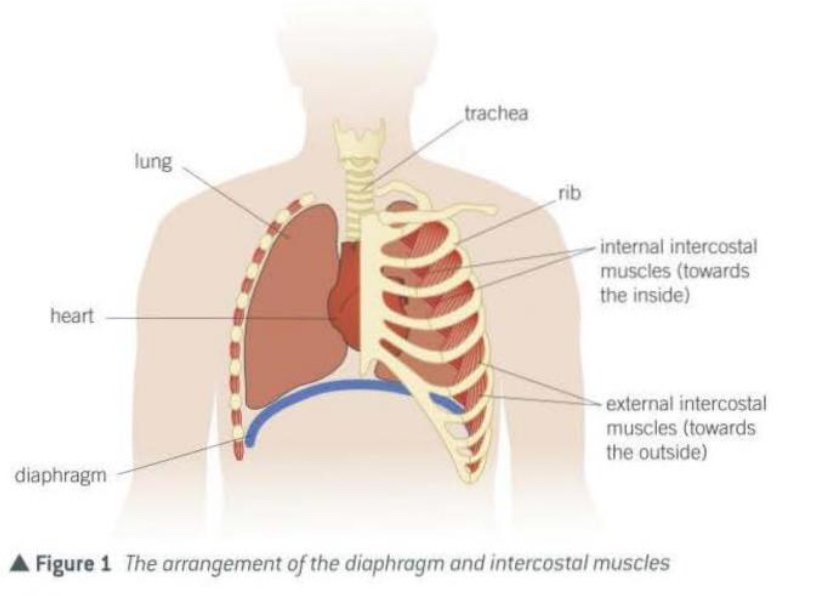
How does inhalation occur?
Diaphragm contracts and flattens.
External intercostal muscles contract, internal relax.
Rib cage moves up and out.
Volume of thorax increases → pressure in the lungs decreases → atmospheric pressure is now greater than pulmonary pressure, and so air is forced into the lungs.
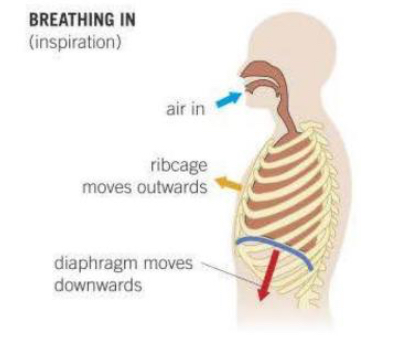
How does exhalation occur?
Diaphragm relaxes and curves up.
Internal intercostal muscles contract, external relax.
Rib cage moves down and in.
Volume of thorax decreases → pressure in the lungs increases → the pulmonary pressure is now greater than that of the atmosphere, and so air is forced out of the lungs.
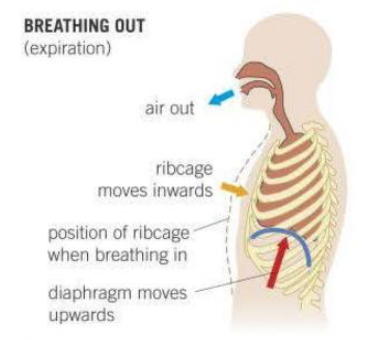
What is ventilation?
The process of moving air in and out of the lungs.
How does gas exchange occur at the alveoli?
Oxygen diffuses from alveoli → blood.
Carbon dioxide diffuses from blood → alveoli down their concentration gradients.
How is the alveoli’s structure related to Ficks law of diffusion?
Large surface area - increased diffusion.
Thin walls - decreased diffusion distance.
Steep concentration gradient - increased diffusion.
Good blood supply - maintains gradient.
How are airways protected against pathogens and dust?
Goblet cells produce mucus and trap particles.
Cilia move mucus to the throat to be swallowed or expelled.
What is the role of surfactant in alveoli?
Reduce surface tension, preventing alveolar collapse.
How does exercise affect the gas exchange system?
Increased breathing rate - more oxygen in, more CO2 out.
Increased tidal volume - deeper breaths.
Increased cardiac output - faster transportation of gases.
What are the main types of lung cancer studied in a level biology?
Chronic obstructive pulmonary disease (COPD) - emphysema, chronic bronchitis.
Asthma
Fibrosis
Infections - tuberculosis, pneumonia.
What is emphysema?
A lung disease where alveoli are damaged and break down, reducing surface area for gas exchange.
What are the causes of emphysema?
Smoking
Air pollution
Long-term inhalation of dust or chemicals
What are the effects of emphysema on gas exchange?
Alveoli walls destroyed - reduced surface area.
Elastic tissue destroyed - alveoli can’t recoil so air gets trapped in the lungs.
Less oxygen diffuses into blood - shortness of breath.
What is chronic bronchitis?
Long-term inflammation of the bronchi that causes excess mucus production which narrows the airways and reduces airflow.
What are the effects of chronic bronchitis?
Airways narrowed - reduced airflow.
Gas exchange less efficient - shortness of breath and coughing.
Increased risk of infection.
What is asthma?
Chronic inflammatory disease of the bronchioles causing reversible airway constriction.
What causes asthma?
Allergens, exercise, stress, pollution → immune system triggers bronchiole constriction and mucus production.
How does asthma affect gas exchange?
Narrowed bronchioles - less airflow to alveoli.
Reduced oxygen intake - shortness of breath.
Reversible with bronchodilators.
What is pulmonary fibrosis?
Formation of scar tissue in the lungs, thickening the alveolar walls.
How does pulmonary fibrosis affect gas exchange?
Thickened alveolar walls - longer diffusion distance.
Less oxygen diffuses into blood - fatigue, shortness of breath.
What is tuberculosis?
Bacterial infection that causes inflammation and tissue damage in the lungs.
How does tuberculosis affect gas exchange?
Damage to lung tissue - reduced surface area.
Scar tissue forms - impaired diffusion.
Symptoms: persistent cough, coughing blood, fatigue.
What is pneumonia?
Infection that causes alveoli to fill with fluid or pus.
How does pneumonia affect gas exchange?
Fluid in alveoli - reduced gas diffusion.
Less oxygen enters blood - shortness of breath, chest pain, fever.
How does smoking contribute to lung disease?
Destroys alveoli → emphysema.
Damages cilia - mucus build up → chronic bronchitis.
Increases risk of infections → pneumonia, TB.
Can trigger asthma attacks.
How do these lung diseases relate to Ficks law?
Gas exchange is less efficient because:
Reduced surface area - emphysema, TB
Increased diffusion distance - fibrosis, pneumonia
Obstructed airflow - decreases rate of diffusion of oxygen into blood - asthma, chronic bronchitis.
What are common symptoms of lung diseases affecting gas exchange?
Shortness of breath
Chronic cough
Wheezing (asthma)
Fatigue
Chest pain
How are some lung diseases treated?
Asthma: bronchodilators, anti-inflammatory drugs
Chronic bronchitis: antibiotics (only if bacterial infection develops), bronchodilators
Emphysema: oxygen therapy, avoid smoking
Fibrosis: no cure, only symptom management
Infections: antibiotics (bacterial), rest, fluids
What are extracellular enzymes?
Enzymes secreted outside the cells to digest large molecules.
E.g. amylase in saliva
What are intracellular enzymes?
Enzymes that work inside cells.
E.g. catalase breaking down hydrogen peroxide.
What is digestion?
The breakdown of large, insoluble food molecules into small, soluble molecules that can be absorbed.